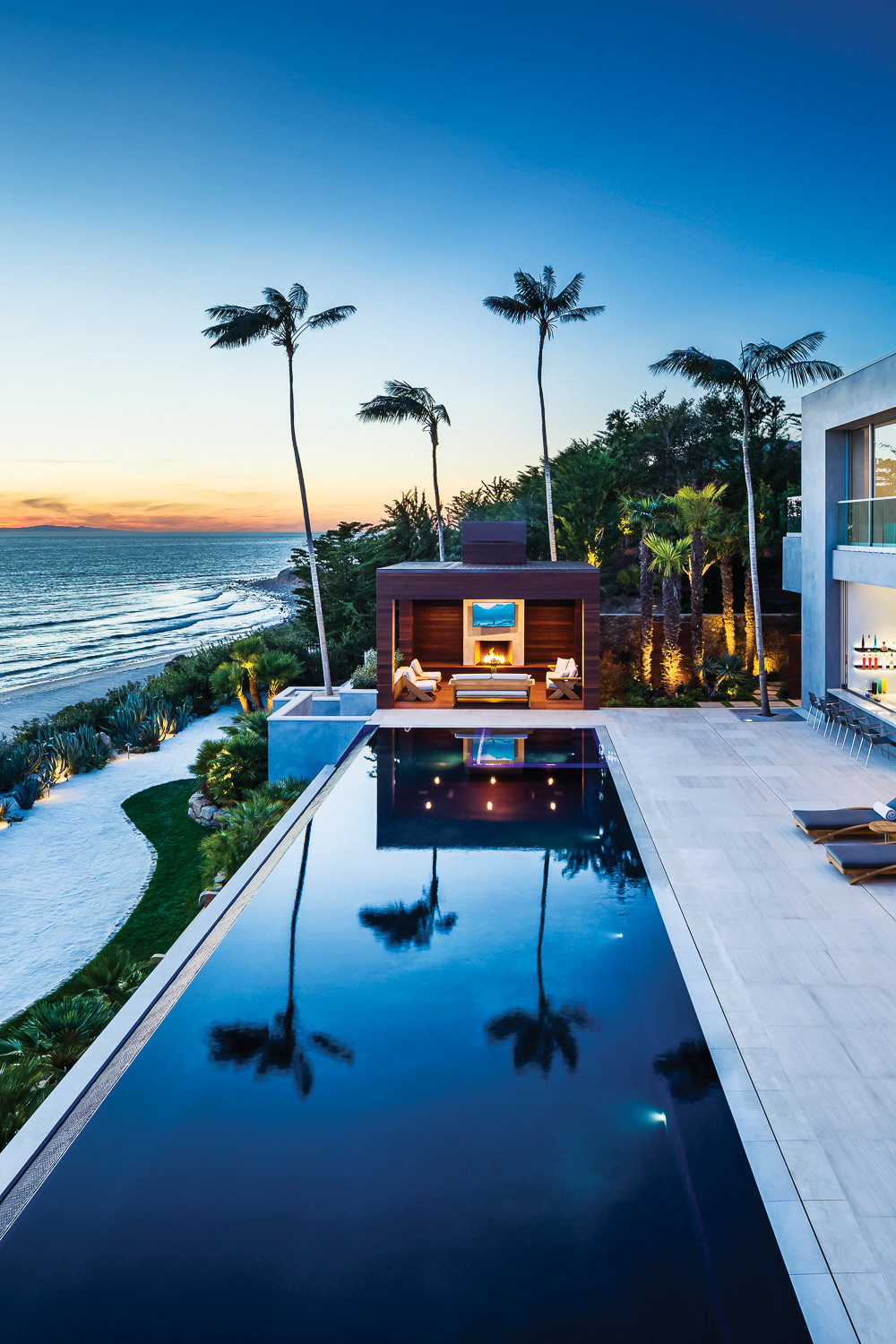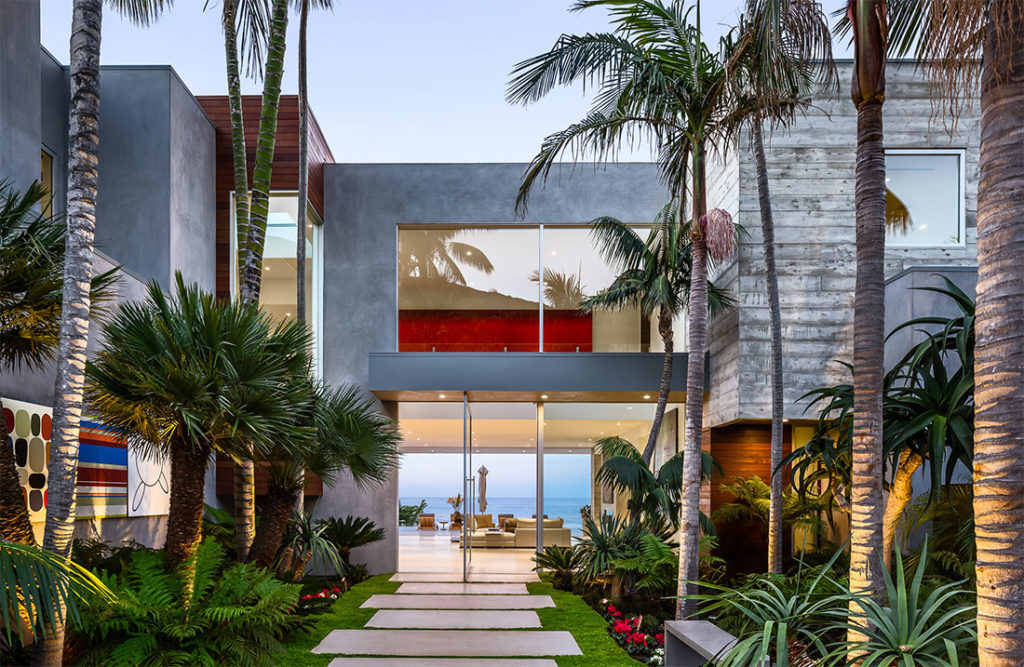Resting serenely on a bluff in Malibu is a 13,335 square-foot residence lifted 70 feet up into California’s rarified air.
It looks past the Pacific Coast Highway below, straight out to an unobstructed, 180-degree expanse of ocean and sky. “There’s a visual, visceral, and auditory view of the water,” says its owner, Ron Heller. “You can enjoy the beach and the privacy of the cliff—and you feel like you’re on the ocean.”


Seventeen properties have been developed in Marisol Malibu, the development where it’s located—with 13 parcels sold, four still available, and seven homes built. All except Heller’s (Marisol 4) have hewed toward more traditional design. So why go contemporary with this one?
“The younger buyers want a more modern design,” says architect Doug Burdge, founder of the Malibu firm that bears his name. “The developer was looking at the marketplace and what to do for the next 10 years since he’s already been successful for the past 10 years.”


And because there was no architectural review board for Marisol Malibu, the developer could do what his architect suggested. “He liked our work flow and floor plan,” Burdge says.
As did Heller. Before he bought the home, he’d already purchased a lot and another more traditional residence in the development. But he became intrigued while he witnessed this minimalist gem under construction. “I watched the house from the day they poured the foundation,” he says. “I walked through it, wondering what it would be like to live here.”
So the former Audi and Land Rover dealer from San Antonio sold his house, bought Marisol 4, then sold his lot. Now he looks out to his own private Pacific with views from his covered patio, private beach and infinity pool, outside a 28-foot-wide expanse of sliding doors.


“It’s about inside to outside living,” he says. “The pocket doors open up from east to west all the way from where the kitchen starts, with 15 feet facing the ocean. There’s one supporting pillar and the rest of the sliding doors open up, right out to the bar area.”
Upstairs on the second floor is a similar configuration for the private living areas. “It’s open from my office on the left side to the master with its long balcony,” he says. “Then you go into the master bath, with white marble and a freestanding tub—and it opens up for an outdoor shower and bath experience.”


It’s all part of the Southern California, inside/outside way of life. If it’s 75 degrees with no humidity, why not open the doors and let the fresh air in? “It’s the way people want to be and the way they were raised,” Burdge says. “It’s the lifestyle in this climate—you can live inside or outside.”
As he worked through the home’s design, Burdge explored the dual concepts of opacity and transparency where appropriate. He created a home that’s hidden as it faces the street, and wide open where it overlooks the ocean. “There were privacy issues on the front, so we used high grasses there,” he says. “It’s opaque there and on the sides, and transparent on the beach side.”
The thoughtful landscaping with tall palm trees and other plantings has an impact on Heller as he approaches the house. “When I drive in, I see how much time was spent with their positioning,” he says. “It’s all arranged in a way that’s very organic.”


The home presents itself in a cinematic way as he pulls in from the street, slips through the gate and heads down the drive. “The descent reveals the home like a movie opening up,” he says. “It has a really tropical feel—and it’s expensive and difficult to do that right.”
That was a deliberate gesture on the part of Burdge, who says that for an approach to the entry of a home like this, the idea is to see nature, and not cars. So he placed the garage and the automobiles out of sight, allowing commanding views to present themselves. “You enter and see the ocean,” the architect says. “You see and explore the house and the surprises around the corners—the den and guest bedrooms are in surprising places.”


With seven bedrooms and 11 baths, the home itself is about 11,800 square feet, with an additional 1,494 square feet under covered porches and pavilions. Gail Coleman of On Pointe Design handled the interiors with custom furniture, and chose finishes that the developer approved. “They spared no expense,” she says.
The lower level of the two-story home features limestone floors, a custom-designed French Oak stairwell, furnishings from Italian manufacturer Minotti, and more French oak for flooring. “It’s marine quality, to work with the humidity and dampness,” she says. “It’s everywhere where there isn’t any limestone—downstairs in all the bedrooms, and it goes up the stairs and carries through the entire second story.”


When she designs a high-end home like this, her focus is to stick with a neutral palette and show the bones of the house, for something that appeals to the masses. “We wanted to keep it comfortable and inviting,” she says. “Having that open view with a lot of glass and light, it kind of evolved—we wanted to keep it simple and not take away from the setting.”
Because it was a developer’s spec house, the architect faced a similar challenge. “You have to guess on the eventual owner, and that they’ll be okay with how big the guest rooms or baths are,” Burdge says. “They have to understand this is a gym and that’s a master, and they have to understand how it will all be used.”
Ron Heller got that, and this spec home’s ceaseless view of the Pacific Ocean, immediately.
For more information, visit buaia.com.


